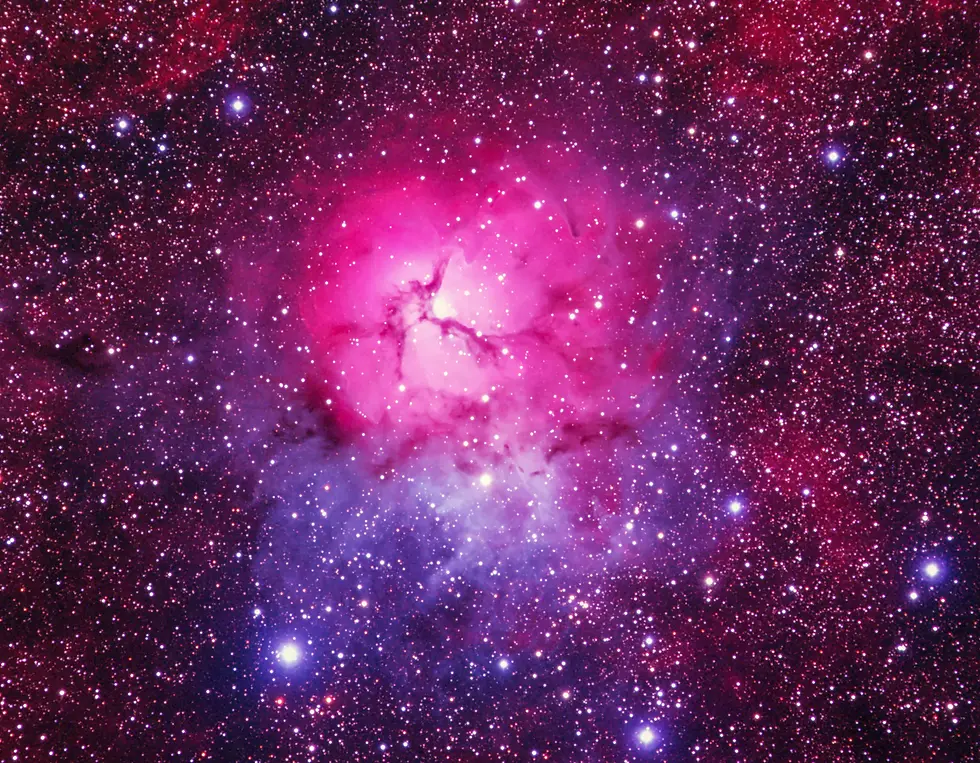The Trifid Nebula

Available in all sizes and media: A2 - A0 in Fine Art Prints and 18" up to 48" widths in Polished Aluminium, Frameless Acrylic and Framed Backlit.
Pop along to the shop HERE and don't forget to use the discount code READER25 on check-out
About the Trifid Nebula
The Trifid Nebula, also known as Messier 20 (M20), is a remarkable astronomical object that captures the imagination with its striking appearance and complex structure. Situated in the constellation Sagittarius, the Trifid Nebula lies approximately 5,000 light-years from Earth, making it a relatively close neighbour in cosmic terms. This proximity allows astronomers and enthusiasts like me to observe and study its features in considerable detail.
The Trifid Nebula is a combination of three distinct types of nebulae: an emission nebula, a reflection nebula, and a dark nebula. The emission nebula portion of M20 glows vividly due to the ionization of hydrogen gas by the intense ultraviolet radiation emitted by hot, young stars embedded within the nebula. This results in the characteristic red hue that dominates many images of the Trifid Nebula.

Adjacent to this, the reflection nebula manifests as bluish regions, caused by the scattering of light from nearby stars off fine dust particles within the nebula. This scattering effect is similar to why Earth's sky appears blue during the day.

The dark nebula, which gives the Trifid its name, is composed of dense clouds of gas and dust that obscure the light from the stars behind it. These dark lanes divide the nebula into three distinct sections, hence the name "Trifid," meaning "divided into three lobes."
One of the most fascinating features of the Trifid Nebula is its role as a stellar nursery. Within its clouds, new stars are being born, a process that can be observed in various stages. The young stars heat the surrounding gas, causing it to glow and further illuminate the nebula. This region is also a hotspot for ongoing star formation, making it a rich field for study in understanding how stars and planetary systems develop.
The Trifid Nebula’s visual allure and scientific significance make it a favourite target for both amateur and professional astronomers. Its diverse components provide a vivid demonstration of the life cycle of stars, from the birth of new stars to the remnants of older ones. Observing the Trifid Nebula through a telescope reveals a tapestry of cosmic phenomena, each layer adding depth to our understanding of the universe. Whether viewed through the lens of a telescope or in detailed astrophotography, the Trifid Nebula continues to be a source of wonder and discovery in the celestial realm. I hope you love my image of this fascinating and beautiful object!
Imaging the Trifid
To get the exquisite detail many hours of imaging is required through a range of different filters. To build up to the hours required I take ‘sub frames’ or images of a shorter duration, which I can later stack together using astronomy software. In this case I used a range of exposures from six hundred seconds to 1200 seconds to build up the time required to capture the detail. In total I captured 22 hours of data.
I used four different filters, Red, Blue, Green and a Hydrogen Alpha (Ha) narrowband filter. The red, green and blue sub frames were six hundred seconds each and the Ha twelve hundred seconds each.
The red, green and blue gives it its colour. The Ha filter captures the star forming regions which in this image is the red area - emission nebula. I then blend this Ha data with the red data to accentuate the detail and beauty.
In addition to capturing the ‘light data’ at various wavelengths, many calibrations are required to create a good photograph. You can see much more about this on my web site www.galaxyonglass.com/about.
I hope you will get much pleasure from this image and the way it is presented, whether that is as a fine art print, acrylic, polished aluminium or framed and backlit. There are so many beautiful objects to enjoy in deep space!
There is so much to look at and enjoy in this fascinating and beautiful image. Every time I look at it I see something new. I hope you like it too and and if you would like to purchase it in one of the media then pop along to HERE And don't forget the JANUARY DISCOUNT OFFER (ending 31st Jan 2025 of 20% - use the code: READER25 on check-out
Chris Baker
.png)
Comments